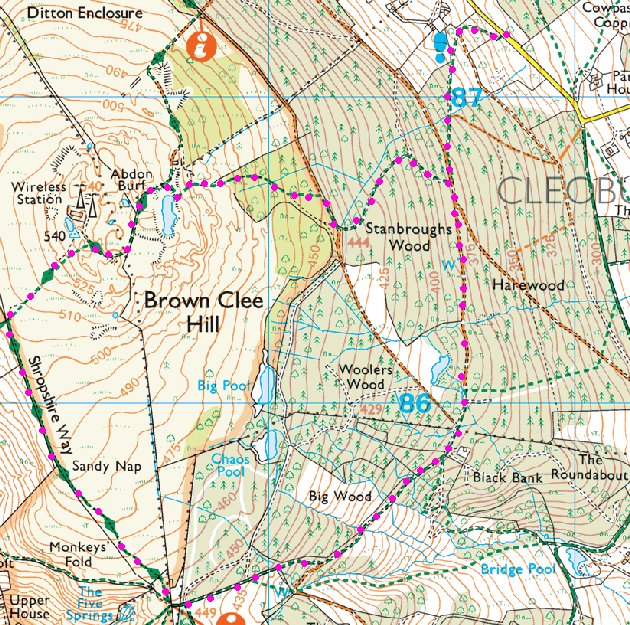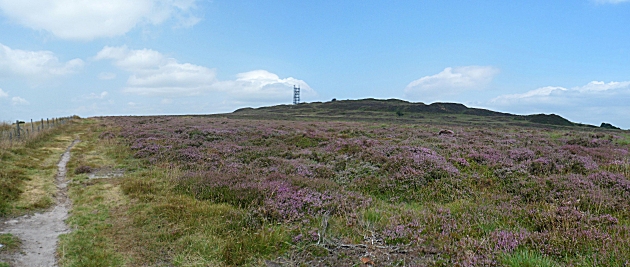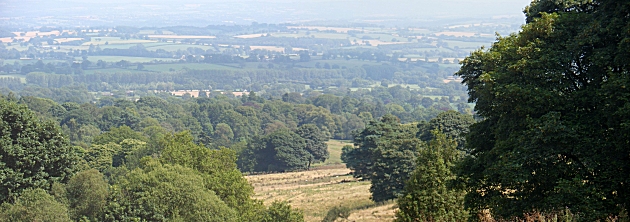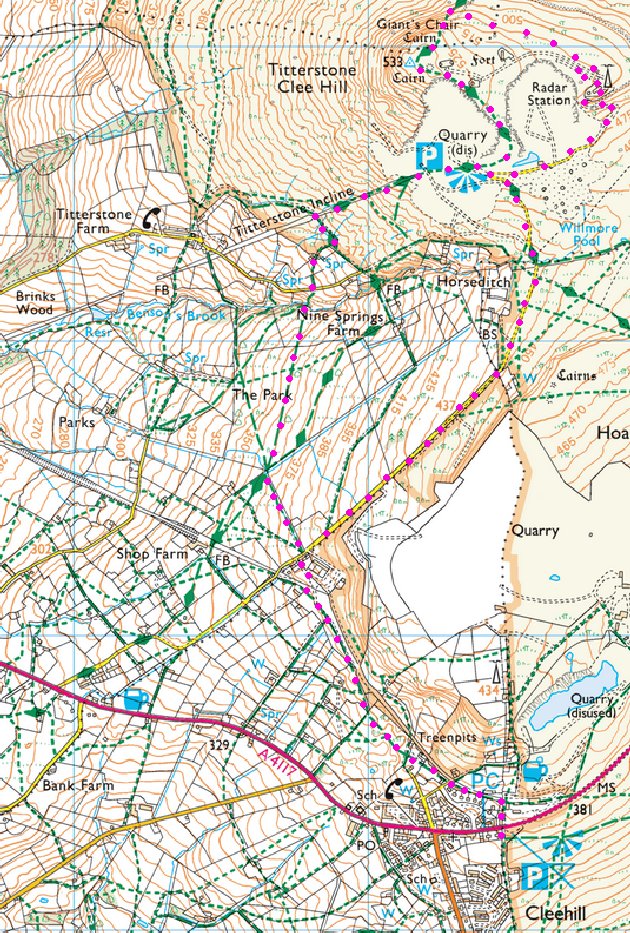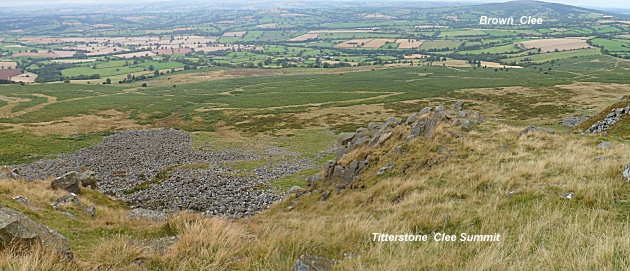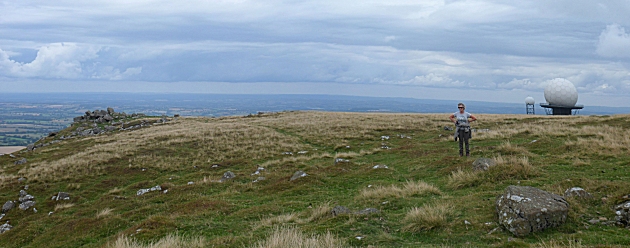Mid Summer 2014


Attingham Park is another stately pile a few miles upstream from us in the Severn valley. It is a large Georgian mansion sitting in a 4000 acre estate with a walled kitchen garden and a deer park.
One family have owned this estate through five generations until it came into the ownership of the National trust in 1947. The family were the Berwicks and their story begins with Noel Hill who was born in London in 1745, obtained an MA at Cambridge in 1766 and practised law before becoming an MP for Shrewsbury and Shropshire from 1768 to 1784. He was elevated to the peerage in 1784 as Baron Berwick, taking his name from the village of Berwick Maviston on the estate his family had purchased after the dissolution. It was later completely demolished as part of the park "improvements".
Running through the estate is the River Tern, a tributary of the Severn which runs alongside, and the first house built here was named Tern Hall. Noel commissioned the building of the present second mansion built around the old Tern Hall in 1782 which was completed in 1785 but he died in 1789 so did not live long to enjoy his new house. His son Thomas who was then only 19 inherited the estate and set off around Europe on a grand tour, as one did in those days, to spend some of pater's accumulated cash.

While in Italy he acquires a large collection of paintings and on his return to Attingham builds a large picture gallery at the back of the hall to house the collection. At the age of 41 Thomas marries a 17 year old whore (politely called a courtesan in those days) called Sophia Dubochet and together they continue to spend pater's cash until they go broke and are forced to hold a bankruptcy sale to cover their debts.
Sophie was one of 15 children and three of her sisters were on the game including Harriette who famously was the mistress of the Prince of Wales, the Lord Chancellor and four future Prime Ministers. Her memoirs, which are still in print, required many volumes so she was a very busy girl. Sophie and Thomas skipped off to Italy where Thomas died in Naples in 1832 aged 62.
His brother William became the third Lord Berwick who was then British Minister to Sardinia who lived in a grand palazzo with a large silver collection from 1807 to 1824 until he was moved to Bologna which he did not much like but was allowed to keep the silver as compensation and much of it is still in the Attingham silver collection.

William it was who demolished the old Tern Hall and died 10 years after inheriting the estate, succeeded by his brother Richard in 1842 who died in 1848 when his son, also called Richard became the 5th Lord Berwick. He died in 1861 and being unmarried his brother, another William inherited but also died unwed in 1882 when they ran out of sons and brothers!
Williams nephew, yet another Richard, was the 7th Baron and lasted until 1897 when his younger brother Thomas Henry (the eighth I am) took over and began the restoration of the house which had gradually deteriorated over previous generations. Thomas served in the army during the Great War in Northern Italy returning to marry Teresa in 1919. He died in 1947 when the house was gifted to the Trust and tragically, Teresa was killed in a car accident at the gates of the Estate in 1972.
Thomas and Teresa had no children and the Barony passed to Thomas's cousin Charles who also died childless so the title then became extinct.
The house served as an Adult Education College from 1950 to 1970 and Percy Thrower used to present BBC gardening shows from here during the 1950's. The National Trust is in the process of spending £1.4 million to repair the glass roof of the Picture Gallery so we will return next year to see all of Thomas's pictures when they are re-hung, the place being full of scaffolding when we visited.

The Walled Garden is almost completely restored and a team of volunteer gardeners are growing organic produce for the cafe and selling the surplus in the shop. Produce is harvested every day so we purchased fresh fruit and vegetables to take home. There is also a large orchard of several acres which has over 170 trees growing many different varieties of apples and pears as well as espaliered fruit trees round the walls of the garden.
A separate walled garden adjacent to the main one grows herbaceous flowers to provide cut flowers for the hall. They were also growing lots of different and unusual things in this area. In the greenhouses they were training cucumbers, courgettes and even melons right up the apex of the roof and someone had made little hammocks to support the Charentais Melons! Not exactly a success as the melons did not seem to like it up there and had split!
In the stables they were selling wooden sculptures of horses reminding us of the play "War Horse". The usual second hand bookshop could not be resisted of course and the coffee was given full marks!

We first visited Kinver Edge in the early spring and thought we should further explore this lovely bit of heathland in the summertime, this time further along the edge to the South West.
Two long distance paths join at the South Western end of the ridge; the North Worcester Path and the Staffordshire Way, the latter starting in the Peak district and running 92 miles to the county boundary of South Staffordshire and Worcestershire on Kinver Edge. South Staffordshire is a stunning little piece of countryside, a strange little salient running North to South, wedged between Shropshire and the West Midlands with Worcestershire at it's Southern tip.
Kinver edge just extends into Worcestershire and the North Worcester Path begins at Bewdley, runs North following the right bank of the River Severn into Shropshire to cross the river at Arley, then East to meet the Staffordshire Way at Kinver edge. It then turns to follow the county boundary off the Edge and East to the Clent and Lickey Hills finishing after 32 miles at Majors Green just South of Birmingham and near Solihull.

On this occasion we parked near the Kinver Farm Shop which is signposted from Kinver and is not really a farm shop as we know it but more of a cafe selling a few fruit and veg. It does have pick your own strawberries and a Maze in the Maize for the kids!
We walked up from here to the top of the Edge then turned South West into Worcestershire to the end of the Edge. Most of the Edge is National Trust property but over the county boundary it is Kingsford Forest Park managed by the Worcester County Council. Here we found a wooden bench which you often find in memory of people who loved such beautiful places but this one was particularly poignant as it was in memory of an SAS soldier who died in 2008, and covered in flowers and little tributes from his wife and kids who were obviously still grieving his loss. The SAS headquarters is only a few miles South West of here in Herefordshire so the area must be home to many such soldiers.
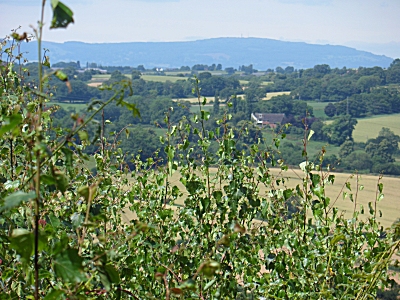
It occurred to both of us how much nicer such a memorial is than a gravestone or other form of memorial. A wooden bench provides a useful purpose and we always read the inscription and wonder about the person who is remembered. It would be even better if we knew what the person did in his or her life.
Walking back along the Edge the views South range from Hagley to the Clent Hills and North into Shropshire with Brown Clee and Titterstone Clee Hills on the horizon. At the iron age hillfort we turned right, back down the hill to the car park to complete a circuit.
We ended up in Stourbridge. This is a bit of a strange town as the centre is surrounded by a one way ring road so that it is sort of on a big traffic island. We went around twice before we found the entrance to the multi storey car park next to Waitrose which was the purpose of our visit. On the way back to Bridgnorth we stopped at the Fox Inn for a pint of Bathams and Sue had a pint of Robinsons cider from Tenbury Wells down in Herefordshire. It is a slightly sparkling, medium sweet refreshing drink that was served chilled and is only sold on tap locally. Nicely refreshing on a hot day after a walk along Kinver Edge.
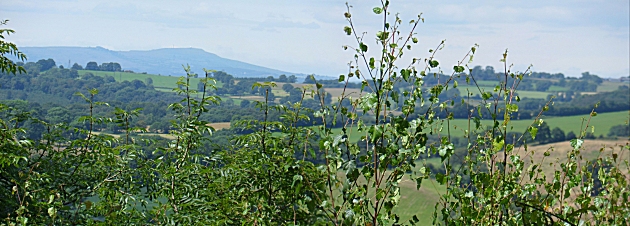
Our next walking route was at the southern end of Wenlock edge starting from Wilderhope Manor. As you can see from the photograph the manor is not pretty, in fact it looks rather grim with the rather dark local limestone of which it is built.

It is older than it looks being built in 1585 it eventually became the property of the Cadbury Trust who donated it to the National Trust on the condition it was used as a YHA hostel which it still is.
During a recent walk along Wenlock Edge I described how Major Thomas Smallman jumped off a cliff to escape Parliamentary soldiers during the English Civil War and Wilderhope Manor was his home. Although he survived his famous leap, the manor is of course still haunted by his ghost!
The manor is located on one of the many footpaths that make up the Shropshire Way and on this occasion we walked North up the Way about 300 yards before turning right along a footpath down into the valley then up onto the ridge where we turned South and followed the ridge until its junction once again with the Shropshire Way.
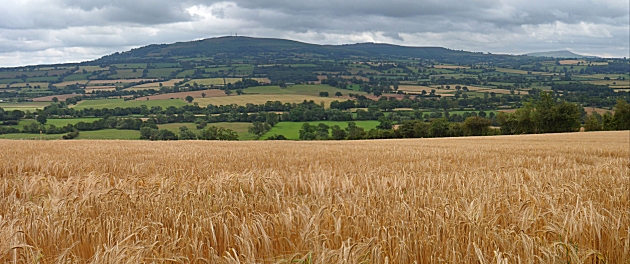
As you can see, the views across a field of barley waving in the breeze were superb. Brown Clee Hill, Shropshire's highest, dominates and away to the right is it's neighbour, Titterstone Clee Hill, just a few metres lower. At the junction of the paths we turned right again to follow the Shropshire Way back to Wilderhope Manor.
The National Memorial Arboretum is situated just North of Lichfield at a place called Alrewas which I am informed is pronounced 'All-re-woos' through which flows the Trent and Mersey Canal where it joins the River Trent. Our friends Sally and Les Harper recommended a good butcher here and especially his Rhino Sausages so we visited Coates and Sons who were still making them. The 40,000 year old skull of a Wooly Rhino was unearthed in the gravel quarry adjacent to the National Arboretum and it was the quarry owners who gave the reclaimed land to the Arboretum charity.
In addition to being a collection of trees, some of which are planted in regimental straight lines more like a commercial plantation than an arboretum, it is predominantly a national memorial to the members of the military and other public institutions.
Having begun by already making one negative comment regarding the way some trees are planted I may as well get all the other negatives out of the way first!
Many trees are also planted much too close together, unlike natural woodland, so that as they grow and mature, no light is let in so nothing grows under the trees. The second criticism is that there are over 300 separate memorials here but not one to the Home Guard?
We arrived with no cash in our pockets so could not feed the car park pay and display meter. Furthermore the shop could not give me cash from my debit card even if I bought something but the manager told me to ignore the parking charge so I did buy something! The point is, it's a charity, they need money and it is 2014 so get an AMD or cashback facility!

The main Armed Forces Memorial was dedicated in 2007 to over 16,000 service men and women who have lost their lives since the end of the second world war. It is a sad fact that our armed forces have been engaged in more than 50 conflicts around the world during that time and are still involved in Afghanistan and the Balkans to the present day.

The memorial lists the name of all those who died and in addition many of the navy, air force and army regiments have their own memorials. There are also memorials to Foreign and Commonwealth countries who fought with and against the British over the years.
One that particularly impressed was the Polish memorial which detailed the involvement of that nation in WW11. Those Poles who escaped the invasion of their country ended up in Britain and were the fourth largest of all the allied forces during the conflict. They also contributed enormously to the resistance movement in occupied territories, particularly in feeding back intelligence and in helping to crack the German Enigma code used for enemy communication. In addition to being a memorial it is a valuable educational guide to remind us of the involvement of the Polish nation in our history.

On the Canadian Air Force memorial was a poem which many will recognise as one quoted by astronauts but few may know anything of the author.
John Gillespie Magee was an American, educated at Rugby School, with a British mother. After finishing his education in America he joined the Canadian Air Force before the USA had entered the war. He wrote the poem 'High Flight' in August 1941 after one of his first flights in a spitfire aircraft. He died after being in collision with a training aircraft over Lincolnshire in December of that same year aged 19.
'High Flight' is the official poem of the RCAF and RAF while American Air Force recruits must learn it by heart.
'Shot at Dawn' is a memorial to those who were shot during the Great War for desertion, cowardice, striking a senior officer, disobeying a lawful order, casting away arms or sleeping at post. Many of those shot were under age and suffering from stress or shell shock which were not recognised then as medical conditions. It was not until 2006 that these men were given an official pardon.
The memorial is a statue of 17 years old Herbert Burden of the Northumberland Fusiliers who was shot at Ypres in 1915. Behind the statue are arranged a number of wooden stakes with the names of others shot during the conflict. In front of the statue are planted six trees to represent the firing squad who had the traumatic task of killing one of their own comrades. They aimed at a medallion hanging from the victims neck, none of them knowing which of their bullets was the one that killed.

On our way back to Bridgnorth we diverted to Bratch Locks which has a turning bridge, a pretty staircase of three locks and an even prettier old toll house on the Staffs and Worcester canal.
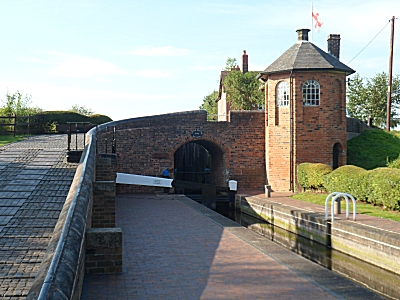
Our real objective was to find a nice little canalside pub where we could enjoy a quiet pint in the garden on this, the hottest day so far this year with the thermometer approaching 30 degrees. The aircon in the car refused to work but we eventually found a pub in Ashbourne near the locks, an attractive village but the pub was not one to recommend.
As forecast, all those thunderstorms came up from France that night and continued the next day allowing me plenty of time to write this nonsense!
A garage in Telford recharged the car's aircon which was last charged in Italy last year. The mechanic told us that the gas can "die" if you don't use the aircon regularly, which we haven't for over a year, so you should switch it on every week summer and winter. Not many people know that!
We travelled over to Belgium again to give Harmonie a wash and brush up and show a couple of potential buyers over the barge. Well we hoped they are "potential buyers" as we seem to get a lot of "tyre kickers" and very few people who are really committed to purchasing a barge. I don't think that Harmonie was what either of them really wanted but both seemed serious buyers this time so you never know.
The Euro Zone countries are still in the economic doldrums so the Brits have the best chance yet to get their hands on a bargain barge which Harmonie is! When the Euro Zone recovers the price will be going back up!
Our mate Normie sent us some interesting information which he has asked me to pass on:
The British Penny - European Union Directive No. 456179
In order to bring about further integration with the single European currency, the Euro, all citizens of the United Kingdom of Great Britain and Northern Ireland must be made aware that the phrase “Spending a Penny” is not to be used after 31 December 2014.
From this date onwards, the correct term will be:
“Euronating”.
It is hoped that this will be a great relief to everyone.
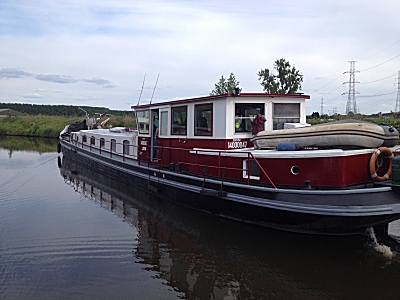
The trip over to Belgium went well and Harmonie was covered in spider shit as usual which took eight hours to clean off. It is one of the drawbacks of not living on board as you usually wash down the boat most days so the muck does not accumulate but you would be amazed how much the little critters can deposit in the two months since we were last there. I suppose spiders keep the fly population in check but Sue is determined to get rid of them. Since we heard that spiders can not live with conkers she is just waiting until the Horse Chestnut trees drop the conkers and we will be like a pair of kids again collecting them! The plan is to hang them round the wheelhouse in little nets so Harmonie will look like an Australian bushman with corks hanging round the brim of his hat to ward off flies!
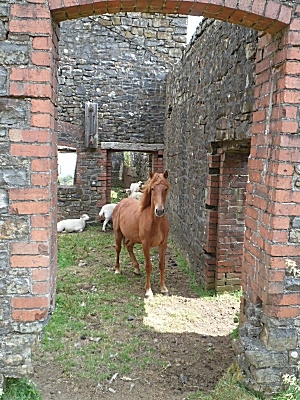
We are fortunate to have this wonder chemical "Ship Clean" on board which you spray on and the shite dissolves in front of your eyes! We even gave Desmond Daihatsu a wash with it!
A trip to Lilly's Chinese on the Sunday night was disappointing as she was closed! The one in Eeklo was also closed as was the usual Brasserie in the square so we ended up having some nice baby Sole with brown shrimps on top, samphire, baby vine tomatoes, a sort of pea puree and Belgian Fries of course at the Leffe bar next door.
They closed the M20 due to a lorry fire on the way back and we spent a good hour stationary before diverting over to Faversham up the M2 and back over to join the M20 at Maidstone. This turned what is normally a 5 hour trip from Dover into a 7 hour one.
Brown Clee Hill, approximately 8 miles from Bridgnorth as the crow flies and about the same distance from Ludlow, is the highest in Shropshire (540 metres) but only 4 metres higher than Stiperstones. This was the next walking destination and we parked our car on the road between Cleobury North and Hillside.
| CLICK HERE TO DISPLAY OR HIDE OUR BROWN CLEE WALK. |
Marcus Samuel (1853 - 1927) was born into a Bagdadi Jewish family running an import/export business from London. Having realised the increasing significance of trading in Oil he ordered eight tankers to be built that were the first to satisfy the safety requirements of the Suez Canal company, enabling him to gain a significant advantage over competitors who could not use the canal. He founded Shell Transport and Trading Company in 1897 which merged with the Royal Dutch Petroleum in 1907 to become Royal Dutch Shell Group which is now the second largest company in the world in terms of revenue.
In 1925 Marcus became 1st Viscount Bearstead and on his death in 1927 his son, Walter Samuel, inherited the title and had also succeeded his father as Chairman of Shell in 1921. Samuel purchased Upton House in Warwickshire in 1927 and proceeded to restore and remodel the house and gardens.

He had become an avid collector and he installed various galleries to house his valuable collection by artists such as Canaletto and Stubbs with the inevitable Bruegal and Bosch given his extensive Dutch connections. Throughout his life he was very philanthropic and helped Jewish families escape Germany in the 1930's. The family was very wealthy and had other houses and estates in the UK and abroad so that after his death in 1948, Upton house and its entire art collection was donated to the National Trust.
The house sits in top of Edge Hill near Banbury next to a steep sided valley on which a kitchen garden was created surrounded by herbaceous borders with a large lake at the bottom. There is also a bog garden and the National Aster Collection which had not begun to bloom when we visited at the end of July.
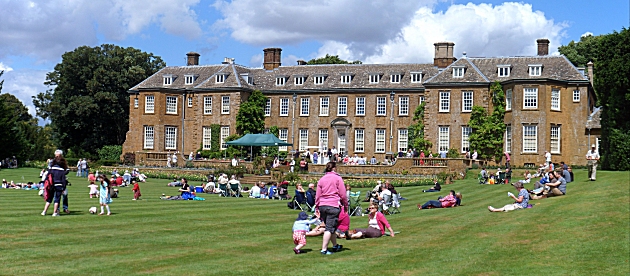
Many visitors were lounging on the lawn in front of the house listening to a jazz band playing 1920's stuff on the terrace. The house itself was unimpressive internally and the art collection poorly displayed. There was a collection of artwork commissioned by Shell over the years for their advertising slogan "You can be sure of Shell" which was interesting as they had produced a leaflet describing the life and work of the various artists responsible for each picture.
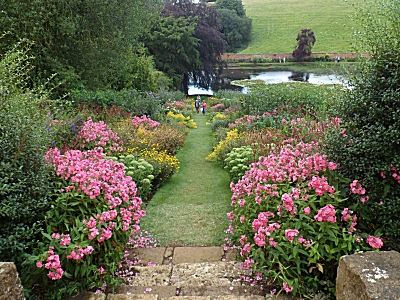
We visited the Castle Pub at Edgehill which served a fine pint of Hook Norton at an eye watering price where we sat out in their beer garden and admired the view over the battlefield. This is the site of the first major battle of the English Civil War where King Charles 1st Royalist Army fought with the Earl of Essex's Parliamentary Army on October 23rd 1642 until they were exhausted, thousands dead and wounded but with no victor. Battle ceased at nightfall with little ammunition left and both armies retreated, Essex to Warwick Castle and Charles to Oxford. Many such battles would take place all over England for the next three years until July 1645 when a Royalist army was defeated at the Battle of Langport in Somerset. The war ended a year later after Charles surrendered and was eventually executed.
Here is the latest funny from Don & Maureen in Newcastle NSW:POSITIVE ATTITUDE!
The patient gradually wakes up stiff as a plank in the hospital's ICU, tubes up nose and down his throat, wires monitoring every function and all around his head, with one hell of a pain over his left ear - with a gorgeous nurse hovering over him.
It was obvious he had been in a serious accident.
She leaned over, looked at the patient and slowly said; “You may not feel anything from the waist down.”
He managed to mumble a reply, “Can I feel your breasts, then?”
NOW THAT'S A POSITIVE ATTITUDE!
I have always suffered from defective hearing, the result possibly of being born in the middle of an air raid with an ack ack gun just behind our house firing at the raiders. My mother told me that the doctor had told her I would be stone deaf as a result but it was not to be. Then I was at sea as an engineer before the introduction of air conditioned soundproofed control rooms or ear defenders which did not help the hearing. In recent years I have begun to say "pardon" more often so after much prompting from all and sundry I went for a hearing test.
| Quotes 'wot I like: Hearing loss very often is such a gradual phenomenon that the person is in denial. You really have to be patient with them in getting them to come forward to get help. Marion Ross 1928 - |
I discovered that my hearing was fine for low frequency sounds but as the frequency increased so it deteriorated and I was advised that hearing aids were to be recommended which friends enthused to me of their efficacy. A visit to my GP was followed by a referral to Specsavers who fitted me with a pair of Siemens Impact Pro L electronic state of the art hearing devices all completely FOC on the NHS in very little time with the minimum of fuss.
I was much impressed with the latest computerised system of both testing your hearing and tuning the hearing devices to the deficiencies of each ear. The devices are almost completely invisible so long as I continue to cheat the barber which I always have done!
On first wearing the devices I was astonished at how much sound I had been missing in everyday life but I am not sure I like it just yet. When I sweep my hair back it is like stroking dried straw! When I walk across a carpet every step has a swishing sound. When Sue turns the page of a magazine or folds up a paper bag it sounds really loud as is the rustling of my clothes when I move. When I play the piano I not only hear the notes I am playing but the mechanical click of each note and that of my finger nail as I hit the note!
| Quotes 'wot I like: I have terrible hearing trouble. I have unwittingly helped to invent and refine a type of music that makes its principal proponents deaf. Pete Townshend 1945 - |
The bird song is already too noisy and when I speak I get an echo. The audiologist tells me that some of these phenomena will disappear in a few weeks as my brain gets used to all these sounds I have not heard for a long time but as I type this the sound from the keyboard is deafening!
I am looking forward to hearing music properly again and anticipate TV, DVD and CD sound will be much clearer if a little different but hope it will still sound natural. If not then you can get the hearing device programed especially for music which you can then select by pressing a button. At the moment the program is automatic so we will see how it works and I can return for more adjustments in a few weeks if I am not happy.
Thomas Telford was responsible for many civil engineering and building projects in and around Shropshire and lived here in Bridgnorth for a time where he designed the parish church behind our house and the town bridge. One of his most spectacular constructions was the Pontcysyllte Aqueduct on the Llangollen Canal which we navigated many years ago on a narrow boat and decided to visit again on foot.

The aqueduct was constructed between 1795 and 1805 as part of, what was then, called the Ellesmere canal. The original plan was to link the River Mersey with the River Severn. The route proposed was from Ellesmere Port to Chester then up to Wrexham. a long tunnel under the Ruabon mountains to Trevor bridging the River Dee at Pontcysyllte then on to Frankton and eventually Shrewsbury.

The Northern part of the canal to Chester was completed as was the Southern part from Frankton to Trevor but the link between them was not, so a feeder canal was constructed to the Horseshoe Falls above Llangollen which was eventually widened for navigation. As the canal system became popular for leisure boating, the canal between Llangollen and what had become the Shropshire Union main line was renamed the Llangollen canal and is perhaps the most scenic in the land.
It is quite an experience to cross the aqueduct on a narrow boat, standing at the tiller looking down 126 feet to the River Dee with nothing but thin air between you and the drop! The aqueduct is just over 1000 feet long and is supported by 18 stone piers. The cast iron trough was from William Hazledines foundry in Shrewsbury who was one of four brothers including John Hazledine who also had a foundry in Bridgnorth in partnership with his other two brothers.

The trough is just under 12 foot wide and just over 5 feet deep and, as you can see from the photograph above there is only a few inches of iron between your boat and a big drop! The total building cost was £47,000 and the same team constructed the Chirk Aqueduct over the River Ceiriog nearby which is only 70 feet high and 700 feet long but a higher railway viaduct runs alongside it so there is no vertigo when you cross it on a boat.
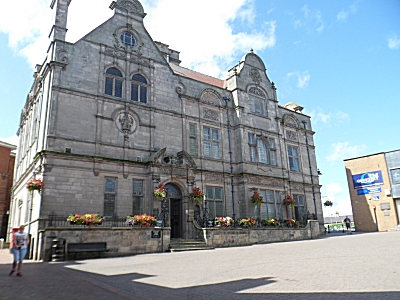
We had lunch at the Corn Mill pub in Llangollen which is not to be recommended for its food or its prices but it does have a lovely setting beside the Dee. I also sampled a poor, flat out of condition ale at the Thomas Telford pub at Trevor basin and walked across the aqueduct but Sue did not join me on account of her vertigo!
We stopped at Oswestry on our return which was another one of the Royalist towns that Cromwell knocked about a bit. It has one of the best preserved Iron Age Hill Forts which dates back to 800BC but the more recent Norman castle was destroyed by act of parliament after the English Civil War with only a few stones remaining so they did a better job than the lot in charge of Bridgnorth castle's demolition.
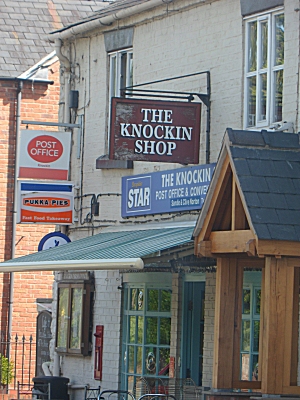
One of the few buildings of note was the town hall which reminded us of old Flemish designs. It is on the small market square which is bordered by three old pubs and an awful modern covered market. I suppose that the planning committee can admire this monstrosity from the town hall and ponder their decision to allow its construction!
We walked down the pedestrianised High Street and along to the pretty parish church alongside the war memorial gardens but apart from that there seemed to be little else to see in Oswestry apart from the Cambrian railway museum situated in the old station building, one of those the infamous Dr Beeching closed down in 1960. It is supposed to be known for the number of pubs it has which is 30 but Bridgnorth can beat it per head of population. We have 27 which is about 450 people per pub (ppp) whereas Oswestry has about 670 ppp!
It does claim to be the biggest market town in Shropshire but its pubs are more crowded!
Continuing back the pretty way we noticed we were on the road to a place called Knockin. I commented that if it had a shop I would stop and take a photograph for the web site. Sure enough it did have a shop and, as you can see from the photo above, the shopkeeper had already read my mind!
We were visited by our friends Mary and John Croxon from Barmy Palmie in Kiwiland who were on the grand tour of Europe so they had to see Shropshire for a couple of days! We took them to Ludlow then over the Long Mynd and finished the tour at Ironbridge Gorge.

Last year I wrote about how Abraham Derby in 1709 discovered how to make iron using coke instead of charcoal at his foundry in Coalbrookdale which heralded the start of what is now called the industrial revolution. In 1781 Derby's grandson, Abraham Derby III, completed the first bridge to be constructed of cast iron over the River Severn at the gorge near Coalbrookdale.
It was a single span of 100 feet between two stone pillars and quickly became a famous visitor attraction. It still is today and the area has become a hugely popular tourist destination promoted as the site of the birth of the Industrial Revolution.
The bridge cost about £6,000 and was subsidised by Derby who manufactured the 380 tons of cast iron required for its construction in his nearby Coalbrookdale foundry. In 1795 a flood carried away all the Severn bridges with the exception of this one and this was probably due to its height above the river and the water being able to pass through the iron girders unobstructed.
Something happened to our cricket team which is difficult to explain. First of all we stopped beating Australia and were whitewashed in the last Ashes series. How the same team went from being the best in the world to practically the worst so quickly is inexplicable!
| Quotes 'wot I like: 'Cricket is basically baseball on valium' Robin Williams 1951 - 2014 |
Dear old Kevin Petersen was sacked, management shifted upstairs and new youngsters bought in but we began the year in the same dismal fashion. You would have predicted a series defeat against India and sure enough they lost the first test by a country mile. "Fire Captain Cook" they all said and they very nearly did but he and the rest of the team then managed to draw a game and eventually not just win the series 3-1 but in the last two games humiliate India, winning easily by an innings. India would probably have needed two more innings to score as many runs as England in the last game, such was Englands dominance with "Dangerous Dhoni" the only batsman to show any resistance! Will England continue its resurgence when they meet Australia?
| CLICK HERE FOR SOME RUGBY COMMENTS. |
| CLICK HERE TO DISPLAY OR HIDE OUR TITTERSTONE CLEE WALK. |
Just South of Stourbridge and only eight miles from the centre of Birmingham are the Clent Hills. Due to its close proximity of this large area of dense population it is a small miracle to have survived being built on, but it has, in no small part to the National Trust who own a large part.

In 1400, 'waste ground' on Clent Hill was declared common ground then in 1770 trees were cut down and standing stones were placed on the summit to form a picturesque backdrop for Hagley Park. It became a popular weekend destination for working people from Birmingham and the Black Country until Lord Lyttelton closed it following "midnight revelling" but the hills themselves remained popular.
In the early 20th century with the advent of better transport and "sharra's" to use the local dialect, the hills became a veritable pleasure ground where you might bring your girl friend for a bit of "'ow's yer father" if you could find a quiet spot in the woods away from the crowds picnicking and drinking in the various beer gardens. With the crowds came the inevitable damage and it was eventually run as a country park until the trust took over in 1995.
The views from the summits of the hills are delightful as are the many well maintained paths and the huge old Beech trees amongst the woods. We only made a half hours circular walk to the top of Clent Hill but intend to return in the Autumn as the leaves turn to explore further.

We continued South to Droitwich and Hanbury Hall, another Trust property. This is a Georgian house built in the early 1700's by Thomas Vernon, a wealthy London barrister. Thomas was a member of the Whig political party and was elected to parliament in 1715 as MP for Worcester. William of Orange had deposed James II in 1689 with the support of the Whigs and Thomas had married Mary Keck, the daughter of the new Kings Commissioner of the Great Seal so had both feet under the table! The Whigs eventually transmogrified into the Liberal party which eventually became the Liberal Democrats in modern times.

Later generations of the family made the inevitable changes to the house and gardens but Emma Vernon (1754 - 1818) decided she didn't like the formal gardens so replaced them in 1770 with the Capability Brown landscaped style favoured at the time. The Trust has since replaced the formal gardens from the original design drawings which survived and very lovely they are too.
The last members of the family to own Hanbury were Sir George Hamilton Vernon and his wife Doris but the marriage was not a happy one and they eventually separated. Sir George took his own life in 1940 leaving the property to the National Trust on the understanding Doris could live in the house which she did until her death in 1962.

The wild flower area planted in the pear orchard above was in full bloom while the apple orchard has hundreds of old varieties which were close to harvesting time. The walled garden grows an extensive collection of fruit and vegetables for the cafes in addition to supplying other NT properties. We had a cream tea in the courtyard of the stable tea room to finish and it did not rain once. August so far has been very cold and wet thanks to hurricane Bertha but the forecast is for summer to return over the coming weeks.
